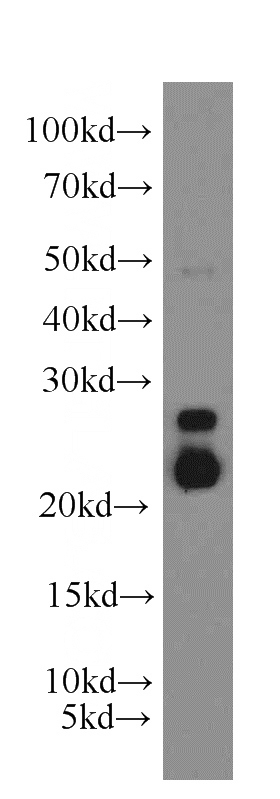-
Product Name
ARL2 antibody
- Documents
-
Description
ARL2 Rabbit Polyclonal antibody. Positive IHC detected in human ovary tumor tissue. Positive WB detected in mouse liver tissue, HeLa cells, mouse lung tissue, mouse spleen tissue, Y79 cells. Observed molecular weight by Western-blot: 21-25 kDa
-
Tested applications
ELISA, WB, IHC
-
Species reactivity
Human,Mouse,Rat; other species not tested.
-
Alternative names
ADP ribosylation factor like 2 antibody; ARFL2 antibody; ARL2 antibody
-
Isotype
Rabbit IgG
-
Preparation
This antibody was obtained by immunization of ARL2 recombinant protein (Accession Number: NM_001667). Purification method: Antigen affinity purified.
-
Clonality
Polyclonal
-
Formulation
PBS with 0.1% sodium azide and 50% glycerol pH 7.3.
-
Storage instructions
Store at -20℃. DO NOT ALIQUOT
-
Applications
Recommended Dilution:
WB: 1:500-1:5000
IHC: 1:20-1:200
-
Validations

mouse liver tissue were subjected to SDS PAGE followed by western blot with Catalog No:108198(ARL2 antibody) at dilution of 1:500

Immunohistochemical of paraffin-embedded human ovary tumor using Catalog No:108198(ARL2 antibody) at dilution of 1:100 (under 25x lens)
-
Background
The ADP-ribosylation factor (ARF) genes are small GTP-binding proteins of the RAS superfamily. ADP-ribosylation factor-like 2 (ARL2) is a member of a functionally distinct group of ARF-like genes. ARL2 interacts with the tubulin-specific chaperone protein known as cofactor D. ARL2 downregulates the tubulin GAP activity of cofactor C, D, and E, and inhibits the binding of D to native tubulin.
-
References
- Nishi H, Ono K, Iwanaga Y. MicroRNA-15b modulates cellular ATP levels and degenerates mitochondria via Arl2 in neonatal rat cardiac myocytes. The Journal of biological chemistry. 285(7):4920-30. 2010.
- Patil H, Saha A, Senda E. Selective impairment of a subset of Ran-GTP-binding domains of ran-binding protein 2 (Ranbp2) suffices to recapitulate the degeneration of the retinal pigment epithelium (RPE) triggered by Ranbp2 ablation. The Journal of biological chemistry. 289(43):29767-89. 2014.
- Mori N, Ishiba Y, Kubota S. Truncation mutation in HRG4 (UNC119) leads to mitochondrial ANT-1-mediated photoreceptor synaptic and retinal degeneration by apoptosis. Investigative ophthalmology & visual science. 47(4):1281-92. 2006.
Related Products / Services
Please note: All products are "FOR RESEARCH USE ONLY AND ARE NOT INTENDED FOR DIAGNOSTIC OR THERAPEUTIC USE"
